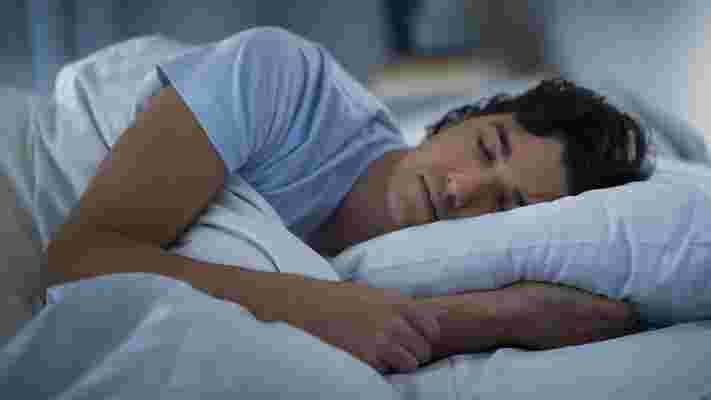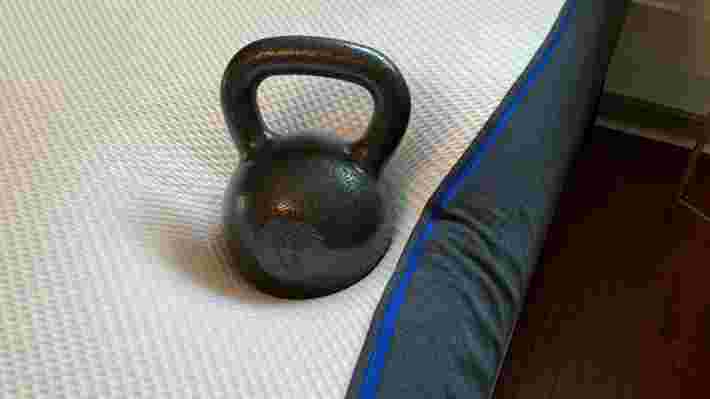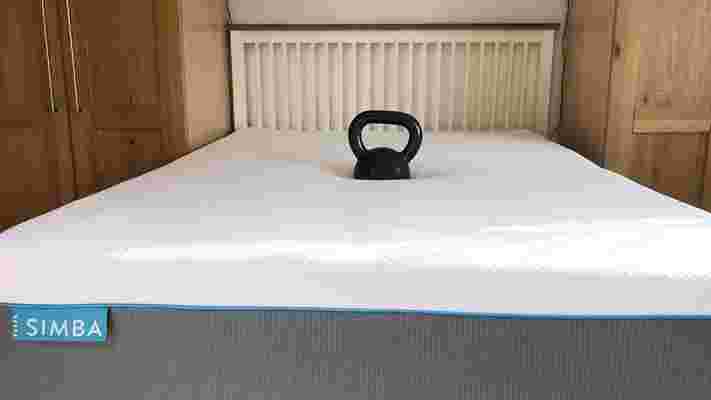The Military Sleep Method might sound tough but it’s designed to gently – and quickly – ease you into sleep within two to three minutes. An old technique used by soldiers, the military method for sleeping can actually be used by anybody and it’s a handy way to get back to sleep if you frequently wake in the night.
However, like anything, it takes regular practice, but once you have the Military Sleep Method nailed you’ll be fighting to stay awake. Here’s what you need to know about this viral sleep technique and how to start using it to fall asleep faster at night and wake up feeling much more refreshed in the morning.
To track your sleep and see how much better you’ll be sleeping once this method becomes fully effective, consider investing in one of the best sleep trackers too.
The Military Sleep Method is a way of getting to sleep quickly – this is ideal if you suffer from insomnia or simply want to drift off to sleep straight away. It’s easy to do, with a series of steps that require nothing but a cozy mattress or somewhere comfortable where you can get good sleep.
While the technique does require daily practice – it needs to be done for up to six weeks in order to be most effective – once you have it nailed, then it can be a great way to help you get to sleep quickly. All it involves is breathing, visualization and a little gentle movement of your fingers and toes.

How to use the Military Sleep Method
This military sleep technique is a straightforward way to get to sleep quickly and involves nothing more than relaxing, practicing your breathing and doing some gentle movement. Here’s how to use the Military Sleep Method to fall asleep fast:
Find a comfortable position where you want to fall asleep and close your eyes.
Breathe out slowly while focusing on releasing any tension in your body, while keep ing your breathing steady and relaxing the muscles in your face.
Relax your shoulders , letting them drop. Your arms and hands should also feel loose and relaxed by your body.
Continue to inhale and exhale steadily, letting the muscles in the legs and feet relax. Try to focus on letting go of any tension.
Gently flex your feet and toes, imaging a warm feeling flowing from head to toe.
Now is the time to start visualizing in order to empty your mind of restless thoughts. Do this by either imagining you are on your back lying on a canoe that is floating on a calm lake, with a clear blue sky above you. OR imagine you are lying on a black velvet hammock in a dark room.
If thoughts start to crowd in, simply repeat the words ‘Don’t think’ for ten seconds. TikTok influencer and fitness expert Justin Agustin tried the Military Sleep Method for himself. Watch the video (below) to find out how he got on.
Can it really help you fall asleep in two minutes?
When practiced every day the Military Sleep Method is a proven way for most people to feel relaxed enough to fall asleep quickly. While some folk might take longer than three minutes, most people do report feeling more relaxed at the very least.
Because the key to most relaxation methods is practice, you might not see the results overnight – literally – but there should be some effect within a week or two. If the Military Sleep Method doesn’t work for you, you still have nothing to lose, as it’s a free, easy and harmless way to relax.
If anything, it will still put you in the mood for sleep and send the signal to your brain that it’s time to wind down – an essential part of a good bedtime routine .
Who created the Military Sleep Method?
The Military Sleep Method is an old technique used by US soldiers to help them fall asleep within minutes – crucial for when they needed to get rest whenever they could in order to stay focused in combat.
In his 1981 book, Relax and Win: Championship Performance , author and sprint coach Bud Winter detailed the ‘The Military Method’ as a way for anyone to fall asleep quickly in order to be at their best during the day.
The sleep technique became popular again when fitness influencer Justin Agustin shared it on TikTok. It work for many of his followers but not all, yet most reported that they felt more relaxed and less stressed or anxious going to sleep.

How to prioritize better sleep at night
If you do have trouble getting to sleep or suffer with insomnia, there are plenty of tricks that can help you get better sleep. This includes cutting down on caffeine a few hours before bedtime. The length of time will vary for different people, but most people find lunchtime works as a cut-off point for the last coffee of the day.
Other tips include cutting down on screen-time up to two hours before bedtime, as well as having a bath or warm shower to help prep the body for sleep. This ties in with making sure the bedroom is the right temperature, and ideally, you should go to sleep in a room that is no warmer than 18 degrees Celsius.
Light stretching or meditation before you get into bed is also recommended, and can also help with the Military Sleep Method once you are beneath the covers.
Finally, finding the best mattress and best pillows for sleep is essential. If your mattress isn’t quite right, then try one of the best mattress toppers too, as these are a quick and affordable way to upgrade your bed if you need to be cooler, cozier or more supported in order to sleep well.
Read more:
This article is part of TechRadar's Sleep Week 2022 (running until Saturday 19 March), a week-long celebration of all things slumber. We'll be bringing you proven techniques and tips to help you sleep better, and have rounded-up all the top-rated tech to transform your sleep.
OpenAI's new DALL.E model turns your words into pieces of art
OpenAI, the AI research startup, has announced DALL·E 2, an update to its text-to-image generator that looks like a serious step forward.
In essence, DALL·E 2 can create art from a natural language input, such as: "a painting of a fox sitting in a field at sunrise in the style of Claude Monet". OpenAI says the goal is to create "original, realistic images and art" that can "combine concepts, attributes, and styles".
It's a seriously impressive feat for a company that has been plugging away at various AI initiatives, including GPT-3 , which can generate pretty remarkable prose.

OpenAI's accompanying research paper goes into a lot more detail on how DALL·E 2 works. Using the CLIP contrastive models, DALL·E 2 runs in two stages: the first creates a CLIP image embed with a text caption and the second generates an image based on that.
The results are highly impressive and could have big ramifications for the art and graphic design industry, especially for video game studios, which currently employ designers to painstakingly construct worlds and concept designs.
DALL·E 2 builds on the work OpenAI did with DALL·E 1, which was announced in January 2021. The name is a combination of Salvador Dalí and WALL·E.
A brave new world
OpenAI is one of the most exciting startups working in the AI space at the moment.
Founded in 2015 by Elon Musk, Sam Altman, Ilya Sutskever and others, the goal is to produce a "friendly AI" that benefits humanity as a whole. The startup, which is a non-profit, competes with Alphabet's DeepMind.
DALL·E 2 is a really great example of this work in practice, pushing the boundaries of what's possible when it comes to generating images using AI. The service can even edit existing images to a user's specification.
There is, of course, a long way to go. The researchers noted that its CLIP foundations can easily be fooled by labelling one item as another. But over time, these kinks will be worked out and improved upon.
OpenAI plans to release DALL·E 2 to select researchers soon.
How we test mattresses: our review process explained
Mattress testing sounds fun, but it’s a lot more work than simply ‘sleeping on the job.’ Buying a new mattress is a big purchase and one that can truly affect the quality of your sleep, so we want to help you get this right first time. A good mattress should last six to eight years (latex mattresses last longer), so pick the right one and you can forget about mattress shopping again for the best part of a decade.
Our mission
To help you find the best mattress for your body, sleep style and budget. These three major factors affect your choice of mattress, so our review process investigates every element of a mattress’ design and build in terms of comfort, support, durability and value for money.
The TechRadar mattress testing process is editorially independent. While we aim to source mattresses directly from manufacturers, we do so under the strict mandate that the manufacturers have zero control over our review process and no input into our testing scores.
As TechRadar is supported by its audience, we may earn a small affiliate commission from any mattress you purchase through our buying guides and reviews. We explain this in more detail here , but this does not affect a) our choice of which mattresses to feature, and b) how we test and rate them.
At TechRadar we’ve written extensively about good sleep, why it matters and how to get more of it. To support this, we regularly interview experts about the latest sleep science, techniques and products, and pass that information onto you so that you can use it to understand your current sleep health and how to improve it.
There are numerous benefits to sleep , with the American Academy of Sleep Medicine recommending adults to get at least seven hours a night. However, research from the CDC tells us that one in three adults aren’t even close to getting that amount. There are many reasons why you might not be sleeping properly and why you keep waking at night , but your mattress could be one of them.
As neuroscientist and chartered psychologist Dr Lindsay Browning tells TechRadar: “Mattresses generally have a life span of seven to eight years. After that, they’re probably not as supportive as they need to be and less comfortable, so your sleep won’t be as good.”

A mattress that’s too firm, too soft or sagging can cause neck and back pain by either putting too much pressure on your main impact points (back, shoulders, hips, knees) or by not supporting them enough. This will lead to uncomfortable, broken sleep, which may develop into symptoms of sleep deprivation .
Older mattresses that haven’t been cared for properly can also become a harbour for dust mites, dead skin, sweat, body oils and bed bugs. Yordan Yordanov, an expert mattress cleaner from Fantastic Services , tells us: “While most people tend to agree that buying a quality mattress is essential for a good night's sleep, keeping it clean is just as important in order to prevent allergies and health-related issues from arising.”
From our years producing expert reviews across multiple product areas, we know how vital it is to fact-check a manufacturer’s claims. We do this by thoroughly testing every mattress we review.
Regardless of whether you are buying an affordable mattress or a luxury model, this is a big purchase; big in terms of how it affects your sleep, which in turn affects your wellbeing and mood. So this is more than just a few slabs of foam and coils nestled together.
By thoroughly researching and testing mattresses, we can be sure that what we are recommending really is the best.
The best way to test a mattress is to sleep on it, so we sleep on each one we review for a minimum of three weeks. Why this timeframe? Some brands say that it takes around 14 days for your body to get used to a new mattress, while others argue that it’s closer to 30 days. We split the difference and sleep on each mattress night after night for three weeks, as we feel this gives us a good overview of how it feels and performs. Occasionally we run long-term tests of up to four months to get a more robust view of performance and durability.

We place one lead reviewer on each mattress, and ask them to sleep on it each night in different positions and on different sides of the bed, whether they sleep solo or with another. Our expert testers gather data throughout this period and make extensive notes about comfort, support, firmness, smell (off-gassing) and temperature regulation.
Each lead reviewer also creates a mini testing panel with sleepers of different body weights, heights and sleep needs. Why? Because we want to create a thorough opinion of the mattress and how it feels to different sleepers. This is vital because mattress firmness is subjective.
Our reviewers also analyze all available user reviews to pinpoint any recurring issues or praise for the mattress. These reviews are particularly helpful for gaining insight into any performance issues that crop up six months or a year down the line. Not all manufacturers display their user reviews in a helpful way though, so this part of the process can be time-consuming.
The key factors we test when reviewing a mattress are as follows:
We also look at the materials (the quality, appearance, feel), and we analyse the mattress in terms of price, value for money, and how both of those compare to the price and value-factor of comparable mattresses. If we feel there is a similar mattress that does the same job for less, we’ll tell you about it.
We collect mattress testing data from our own in-house tests, user reviews, and from data shared by the manufacturers, which we fact check. When pooled together, this enables us to create comprehensive reviews and to recommend only the mattresses that can help you sleep better.
We collect metrics in the following areas:
We use simple yet effective tests to gather data in the above areas, and this is our process…
Mattress firmness The common way to rate mattress firmness is on a scale of 1-10, with 1 being ‘as soft as a marshmallow’ and 10 being ‘like sleeping on a plank of wood’. But as we have discovered through analysing mattresses and sleeping on them, one manufacturer’s firm is another manufacturer’s medium. This is troublesome for you because how do you know you’re really getting a medium firm mattress?
We rate firmness according to how it feels to our lead reviewer and the testing panel. Sometimes this rating matches the manufacturer’s, sometimes it doesn’t. The great thing is that with any mattress you buy online, you’ll get a trial period to test whether the firmness suits your body and sleeping position/s.

How we test firmness Our main approach is to relax and sleep on the mattress, and while our lead reviewer does the bulk of this, we also invite a testing panel to do the same. As these sleepers have different body weights and types, we’re able to gain a good overview of how different people experience the firmness.
In addition to sleeping on the mattress we also perform a weight test. For this, we place a 25kg weight in the middle and measure (in inches) how far it sinks in. We can then compare this measurement with data from other mattress reviews.
Pressure relief When a mattress delivers good full-body support it will redistribute your weight (and your partner’s, if you share a bed) to reduce pressure on key impact points such as your back, hips and shoulders. Basically, anywhere your body pushes down into the mattress. The other big factor is spinal support – a too-firm bed will add pressure to your shoulders and hips, while one that’s too soft will lead to back pain as you’ll sink into the mattress too much in your mid section.
How we test pressure relief Our mattress reviewers lie down in different positions for varying amounts of time. They start off on their back, before switching to each side, and then finally lying on their stomach. They then score the pressure relief out of 5. They’ll repeat this process with a member of the testing panel so that they can look to see if there’s any unnatural curvature of the spine taking place.
Where available, we also analyze pressure relief testing data shared by the manufacturer to see how this tallies with our real-life experience.
Motion isolation This relates to how well a mattress prevents motion from being transferred from one side of the mattress to the other. While you may not think so at first, this is an important feature for couples who share a bed as good motion isolation means you won’t be disturbed as much by each other’s in-bed movements.
How we test motion isolation The first way we test is for our lead reviewer to lie down on the mattress next to a member of the testing panel. While the lead reviewer remains still in one position, the other tester will:
This process is repeated by the lead reviewer, with the tester lying on the mattress to experience the motion isolation for themselves. We repeat this with as many twosomes as allowed by the number of people in our testing panel.
Our second motion isolation test involves a wine glass and a 6KG weight. We place the glass on one side of the mattress, in the spot a person would normally lie. Then we drop the 6KG weight from a distance of roughly 25” away, where another person would normally sleep. We record whether the glass remains still (good motion isolation) wobbles or tips over completely.
We then repeat this test but from 12 inches to simulate a person getting into bed, then from 8 inches to simulate a person jumping into bed. All of this data we publish in our final review.
Edge support This is an important feature because good edge support makes it easier for you to get in and out of bed. It also means you can sit on the edge of your bed to get dressed or put your shoes on without feeling as though you’re about to slip off.
How we test edge support Our lead reviewer will sleep close to the edge of the mattress in multiple positions, and on both sides to make sure the edge support is equal. We also perform another weight test, this time going back to the 25KG weight. This is placed near the edge of the mattress where we measure, in inches, how far down that side sinks. We take measurements for the left and right side and the bottom to see if the edge support is equal all around or not.
We have a number of expert mattress reviewers carrying out our testing. These include experienced testers based in the US and in the UK, who between them have reviewed all common mattress types such as memory foam, hybrid, innerspring and organic.
In addition to having one lead reviewer per mattress, we also invite a select panel of other testers to relax and sleep on the mattress, rating it in terms of comfort, support, temperature regulation and more. We also provide a full and clear bio for each of our testers so that you can view their experience and why they are best-placed to review mattresses.
Our mattress review team is headed up by Sleep Editor Claire Davies, and if you would like to join our team of testers, you can drop Claire a line here: sleeptalk@futureneom
We create our own review imagery because we want you to trust that we are physically testing these mattresses. We also want you to see what each one looks like in a real bedroom without fancy studio lights, as often they do look different to how they appear in press images.
We take photographs at different points during the review process, starting with unboxing so you know how yours will arrive (the box it comes in and the packaging you’ll have to discard).
Here are some examples of our mattress testing imagery…
We can’t all agree on everything, and it’s the same with review scores. Not every website awards the same score to a mattress, and this comes down to varying testing criteria, the person or team reviewing the mattress, and other factors.
TechRadar mattress reviews are extensive and we clearly set out within each review how we have generated the overall score, as well as sub-scores for key factors such as pressure relief, motion transfer and temperature regulation. If a manufacturer disagrees with a score that we have created based on our test data and review experiences, we do not change it simply because they wish it were a higher rating.
We triple-check all facts we include about the mattress too, and on the off-chance that we do report on an aspect of the mattress’ specification or design incorrectly, we’ll change this in the copy.
